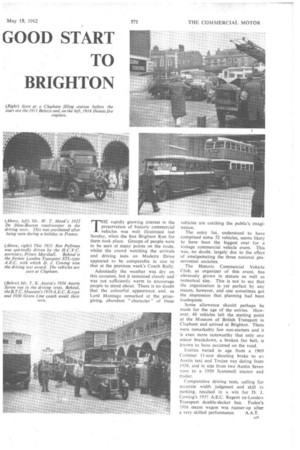GOOD START TO BRIGHTON
Page 59

If you've noticed an error in this article please click here to report it so we can fix it.
THE rapidly growing interest in the preservation of historic commercial vehicles was well illustrated last Sunday, when the first .Brighton Run for them took place. Groups of people were to be seen at many points on the route, whilst the crowd watching the arrivals and driving tests on Madeira Drive appeared to be comparable in size to that at the previous week's Coach Rally.
Admittedly the weather was dry on this occasion, but it remained cloudy and was not sufficiently warm to encourage people to stand about. There is no doubt that the colourful appearance and, as Lord Montagu remarked at the prizegiving, abundant "character" of these
vehicles are catching the public's imagination.
The entry list, understood to have comprised some 52 vehicles, seems likely to have been the biggest ever for a vintage commercial vehicle event. This was, no doubt, largely due to the effect of amalgamating the three national preservation societies.
The Historic Commercial Vehicle Club, as organizer of this event, has obviously grown in stature as well as numerical size. This is not to say that the organization is yet perfect by any means, however, and one sometimes got the impression that planning had been inadequate.
Some allowance should perhaps be made for the age of the entries. However, 48 vehicles left the starting point at the Museum of British Transport in Clapham and arrived at Brighton. There were remarkably few non-starters and it is even more noteworthy that only one minor breakdown, a broken fan belt, is known to have occurred on the road.
Entries varied in age from a 1909 Comrner 11-seat shooting brake to an Austin taxi and Trojan van dating from 1938, and in size from two Austin Seven vans to a 1930 Scarnmell tractor and trailer.
Comparative driving tests, calling for accurate width judgment and skill in parking, resulted in a win for D. J. Cowing's 1937 A.E.C. Regent ex-London Transport double-decker bus. Foden's 1916 steam wagon was runner-up after
a very skilled performance. A.A.T.




















































































































